





TRIP REPORT OF HAUNTED GHOST TOUR TO IRELAND, MAY 5-12, 2013
by Debe Branning
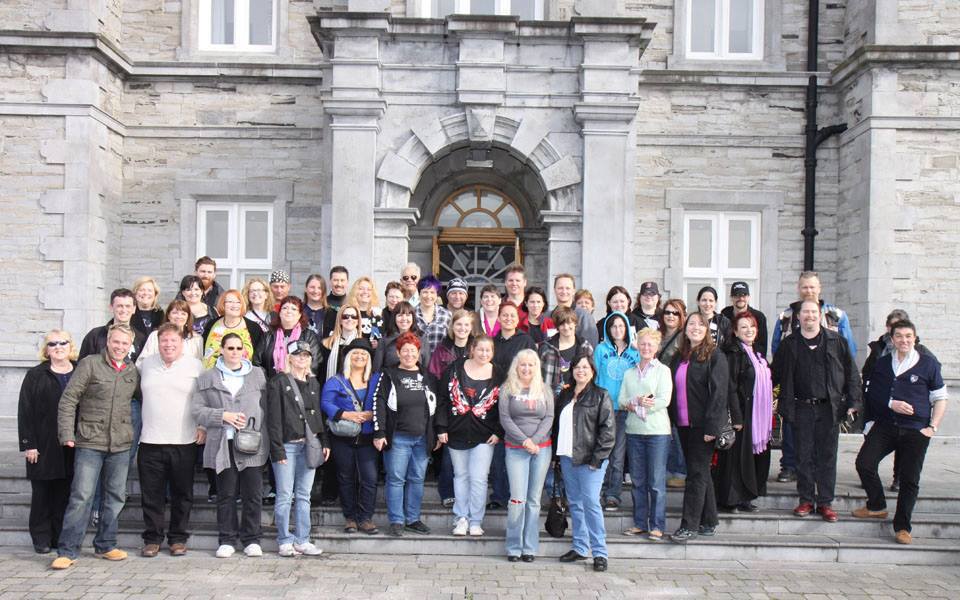
Photo by Rose Schledwitz
Day 1: Malahide Castle, Newgrange, Trim Castle, Clarion Hotel Sligo aka Old Insane Asylum
Our tour host, Most Haunted's Richard Felix, was at the Dublin airport to meet the 48 arriving guests on the tour. A great number of the group was Tours of Terror alumni who have gone on the GHOSTour or DraculaTour (or both) before, so it was like one big family reunion once everyone got together again. Richard had recently broken his arm so his son, Edd Felix, came along to assist his father. We walked out to the bus loading zone where we met our driver, Daithi. We climbed on board the luxury coach and awaited our first adventure.
The tour began at Malahide Castle. Malahide Castle and Gardens is one of the oldest castles in Ireland, set on 260 acres, this magnificent & historic 12th century castle has been home to the Talbot family for over 800 years. We explored the history of Malahide Castle and Gardens by looking at the lives, experiences and adventures of the Talbot Family on a guided tour.
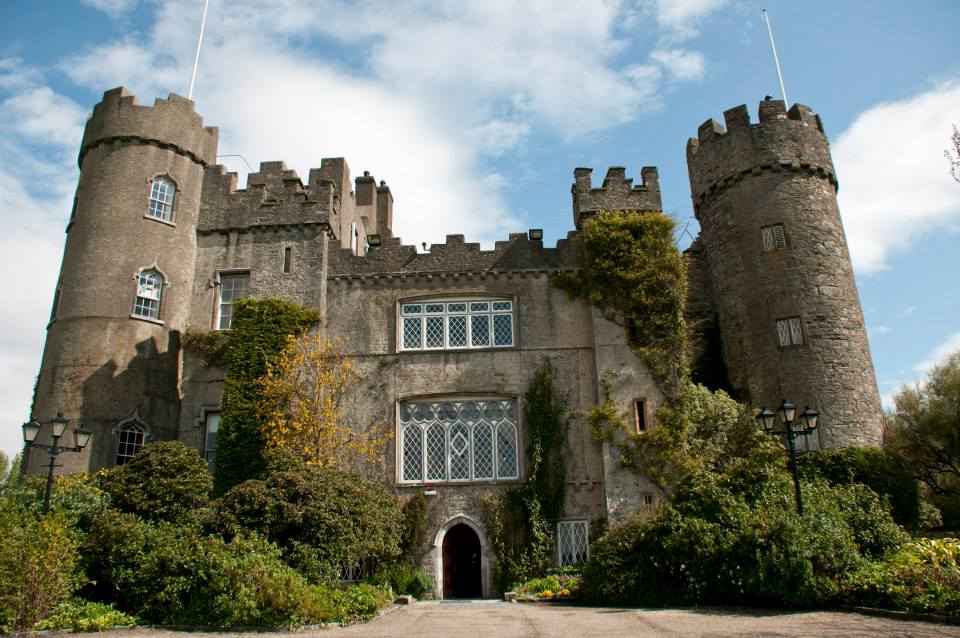
Malahide Castle : Photo by Cindy Grant
Malahide Castle is loaded with ghosts. The ghost of young Lord Galtrim, Sir Walter Hussey, son of the Baron of Galtrim, was killed in battle on his wedding day in the 15th Century. Lord Galtrim wanders through the Castle at night pointing to the spear wound in his side and dreadful groans are heard. It's said he haunts the Castle to show his resentment towards his young bride, who married his rival immediately after he had given up his life in defense of her honor and happiness
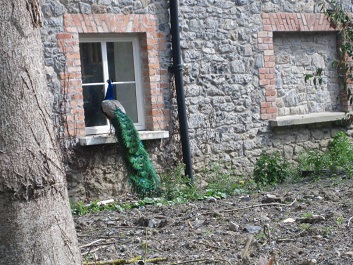
Malahide Castle : Photo by Rick Wells
The second ghost is Lady Maud Plunkett who does not appear as she did on the day of her marriage to Lord Galtrim, but as she looked when she married her third husband, a Lord Chief Justice. At this time she had become notorious in her ghostly appearances for chasing her husband through the corridors of the Castle
The third ghost is more interesting, especially historically speaking. His name is Miles Corbett, the Roundhead to whom Cromwell gave the Castle and property during his protectorate. He was deprived of his property and made to pay the penalty of crimes he committed during his occupancy, which included the desecration of the chapel of the old abbey near the Castle. He was hanged, drawn, quartered and when his ghost first appears it seems to be a perfectly whole soldier in armor, but then falls into four pieces before the eyes of anyone who has the unpleasant experience of meeting it.
In the 16th Century the Talbots always had a jester among their retinue of attendants. One of these jesters, "Puck" by name, fell in love with a kinswoman of Lady Elenora Fitzgerald, who was detained at the Castle by Henry VIII because of her rebel traits. One snowy December night the jester was found close to the walls of the Castle stabbed through the heart, a tragic figure in his gay jester suit and cap and bells. Before he died he swore an oath that he would haunt the Castle until a master reigned who choose a bride from the people, but would harm no one if a male Talbot slept under the roof. Poor little Puck and his last appearance were reported during the sale of the contents of the Castle in May 1976. His little dwarf figure makes its appearance in many photographs in the Castle and there is one outstanding photograph which shows his old bewitching and wrinkled face peering out of the ivy on the wall.
And of course there is the "white lady". For many years, the painting of a very beautiful anonymous lady, in a flowing white dress, hung in the Great Hall of the Castle. Nobody appeared to know her identity or the identity of the artist who portrayed her. It had been recorded that from time to time she would leave her painting and wander through the Castle in the quiet of the night. Reputed to have been seen by a number of people, over a period of many years, she has become known as the White Lady.
The group paid a much-too-short visit to Newgrange. Newgrange was constructed over 5,000 years ago thus making it older than Stonehenge in England and the Great Pyramid of Giza in Egypt. Newgrange was built during the Neolithic or New Stone Age by a farming community that prospered on the furtile lands of the Boyne Valley. Archaeologists classified Newgrange as a passage tomb. However, Newgrange is now recognized to be an ancient temple-a place of astrological, spiritual, religious and ceremonial importance, much as present day cathedrals are places of prestige and worship where dignitaries may be laid to rest. Newgrange is a large kidney shaped mound covering an area of over one acre, retained at the base by 97 stones, some of which are richly decorated with megalithic art. The 19-meter long inner passage leads to a cruciform chamber with a corbelled roof. The amount of time and labor invested in construction of Newgrange suggests a well-organized society with specialized groups responsible for different aspects of construction.
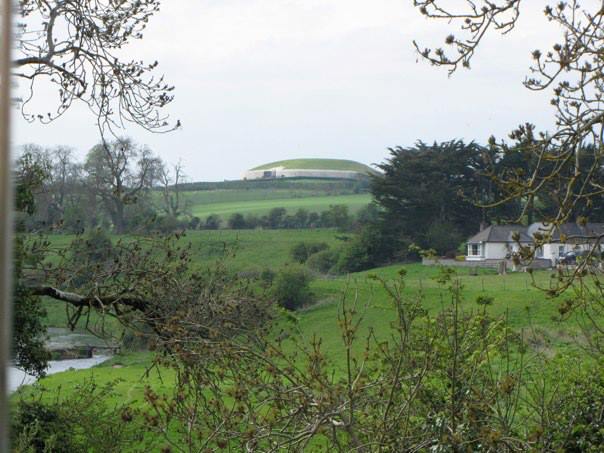
New Grange : Photo by Ed Snell
The group's last stop of the day was at Trim Castle.the largest Anglo-Norman castle in Ireland, was constructed over a thirty-year period by Hugh de Lacy and his son Walter.
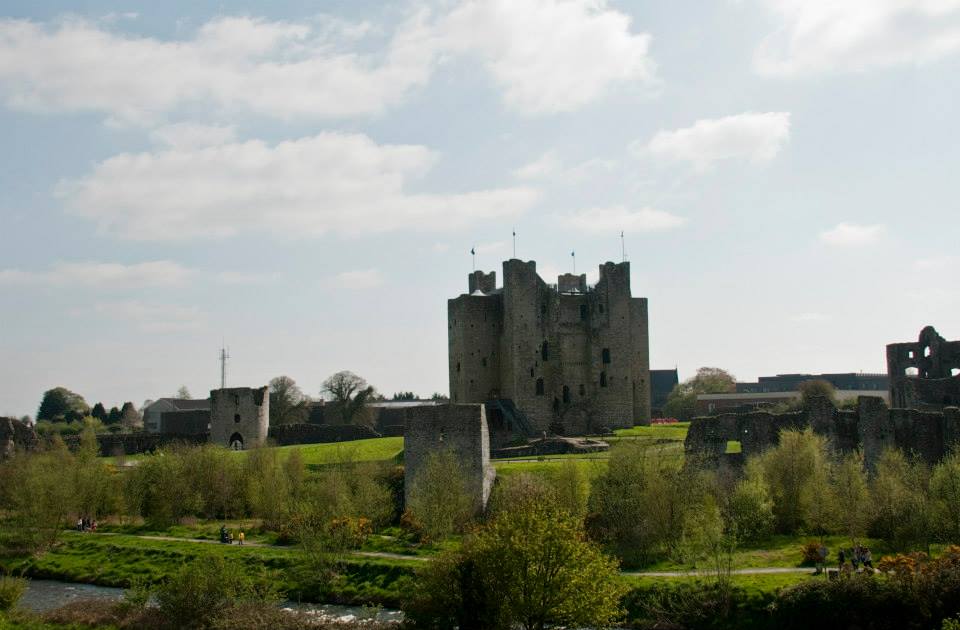
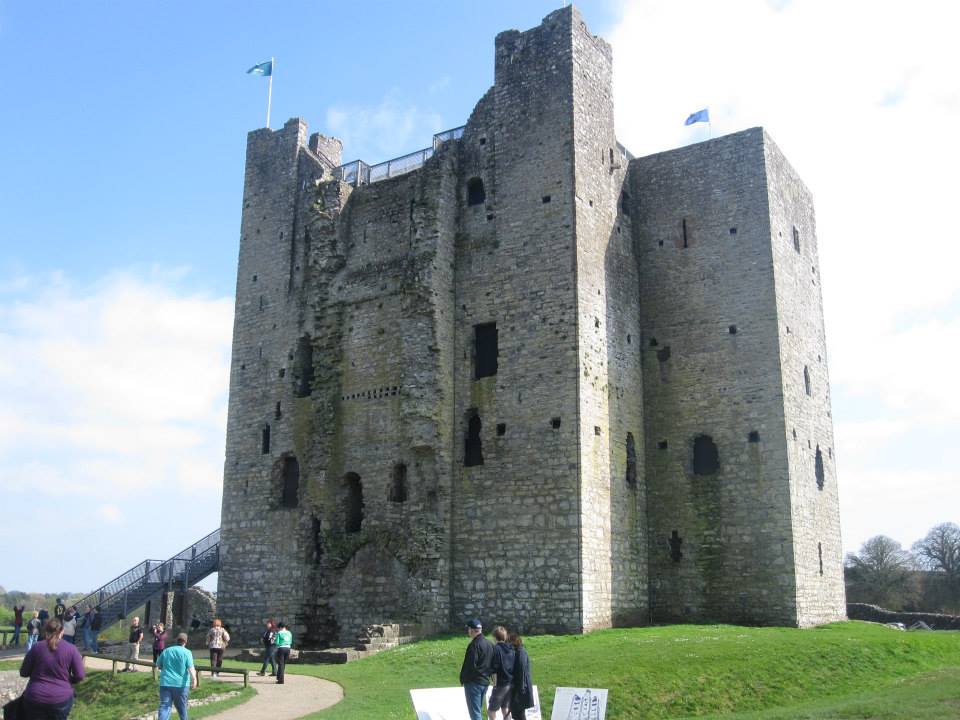
Trim Castle : Photo by Cindy Grant Trim Castle : Photo by Rick Wells
Trim Castle, Hugh de Lacy was granted the Liberty of Meath by King Henry II in 1172 in an attempt to curb the expansionist policies of Richard de Clare. Construction of the massive three storied Keep, the central stronghold of the castle, was begun around 1176 on the site of an earlier wooden fortress. This massive twenty-sided tower, which is cruciform in shape, was protected by a ditch, curtain wall and moat. Trim Castle is what movies are made of. Movie makers of 'Braveheart' chose Trim in County Meath as the shooting location for their epic saga. A view of Trim Castle's stony outline against a dramatic Irish sky relates times of valiant warriors and timid monks protecting the land. Monks have been seen wandering throughout the ruins and guests in the Trim Castle Hotel across the road have seen nuns playing in their rooms. The hotel sits on the grounds of an old Cemetery for nuns.
We then were whisked away to Sligo for our stay at the Clarion Hotel Sligo-or what is known to be the old Insane Asylum! What happened during the night? What happened to the wheel chair stowed in the bus?
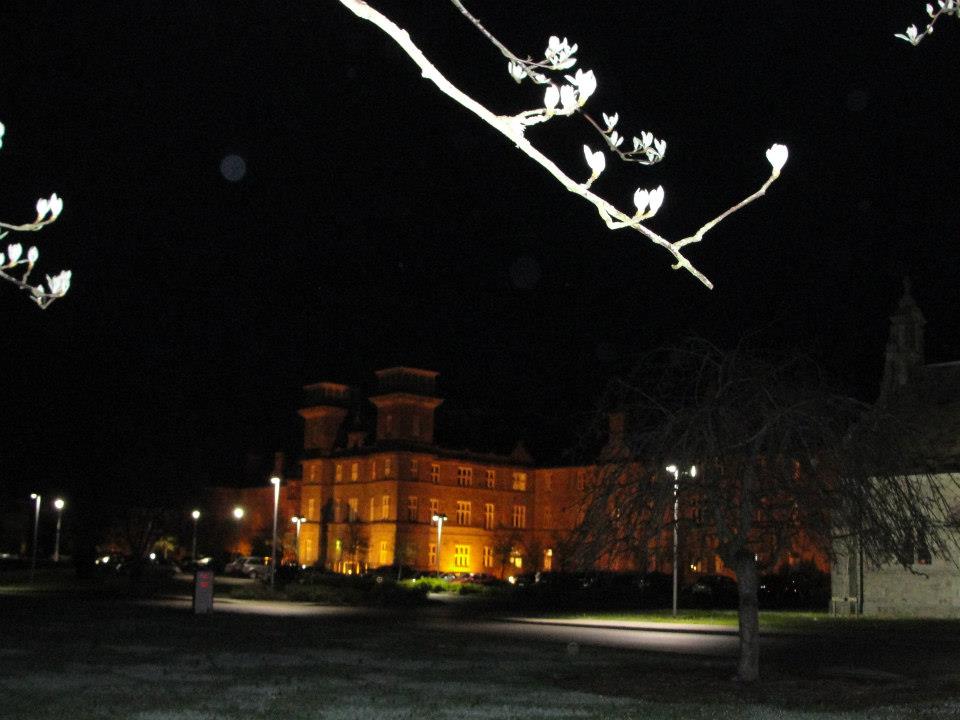 Clarion Sligo Hotel at night : Photo by Suzie Dwyer | 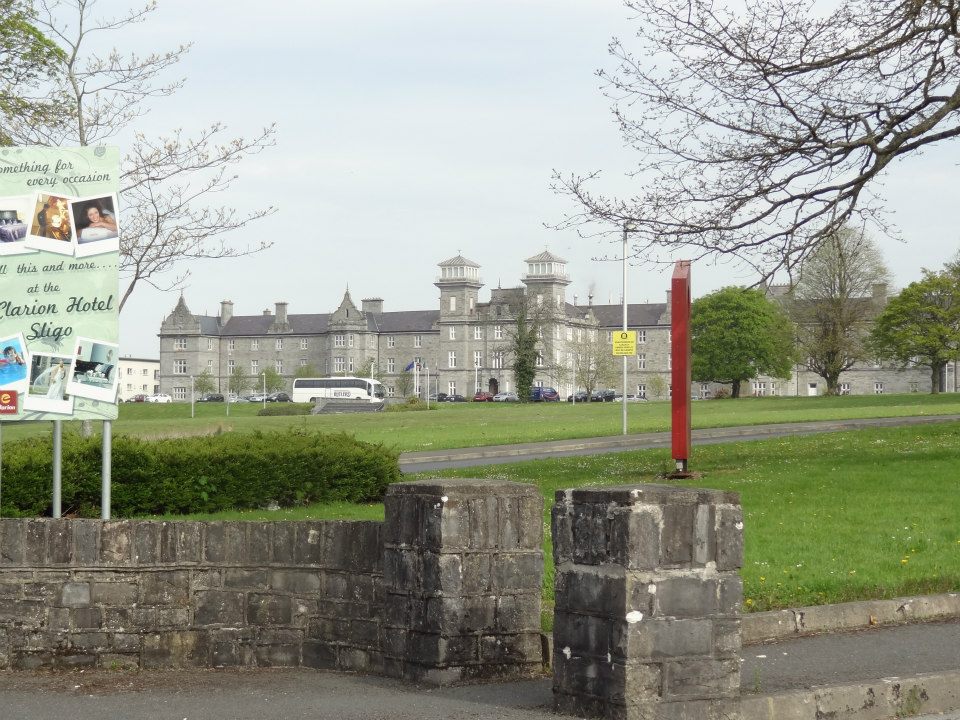 Clarion Sligo Hotel : Photo by Rose Schledwitz |
By the early morning, the "inmates" of the old lunatic asylum (now the Clarian Hotel Sligo) felt refreshed and ready for another day of adventure. The group posed for a group picture in front of the building and down by the old hospital signage
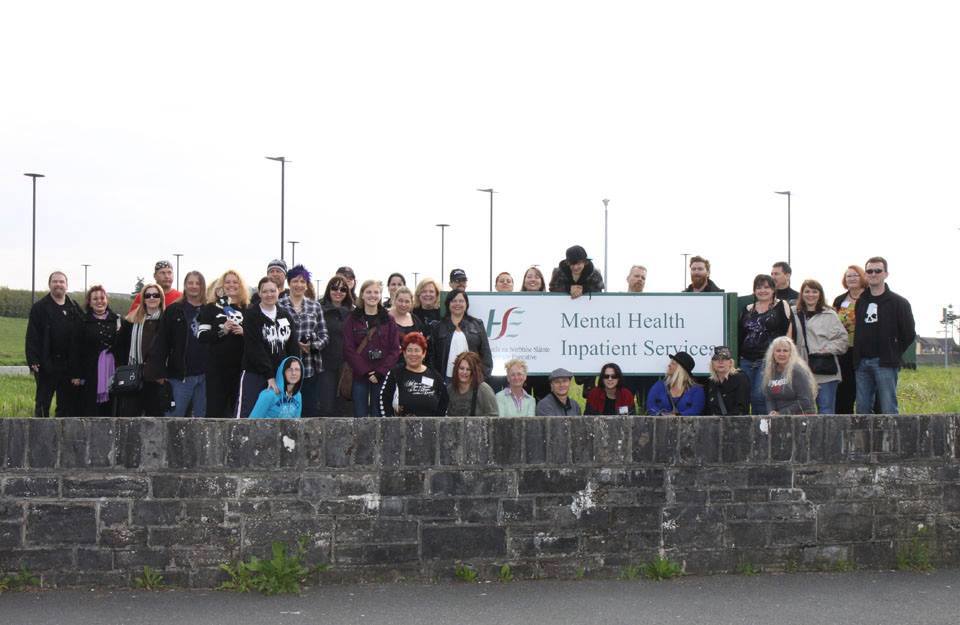
Trim Castle : Photo by Rose Schledwitz
The tour group had barely boarded the bus when someone noted they needed something from their luggage stowed below. As the "wings" of the luggage compartment began to rise, the wheelchair took flight, landed on the ground, and started down the steep driveway toward oncoming traffic at the street below. Quick thinking, Edd Felix ran down the driveway, hopped into the runaway wheelchair and coasted toward the street-slowly bringing it to a halt. Did we have a runaway ghostly inmate from the former Asylum trying to make their getaway?
A short drive through Sligo brought us to Sligo Abbey. Known locally as "The Abbey", this Dominican Friary was founded in the mid-13th century by Maurice FitzGerald. The site contains a great wealth of carvings including Gothic and Renaissance tomb sculpture, well preserved cloisters and the only sculptured 15th century high altar to survive in any Irish monastic church. After the guided tour, the guests photographed old tombstones and tombs scattered throughout the grounds. The graveyard once extended across the road and residents of the flats (apartments) sometimes reported cupboard doors opening and shutting and a feeling of being watch. During the times of Cromwell a number of monks were hung, drawn and quartered for not giving up their faith. And during the times of the plague or cholera outbreaks dying victims were tossed over the walls to be buried.
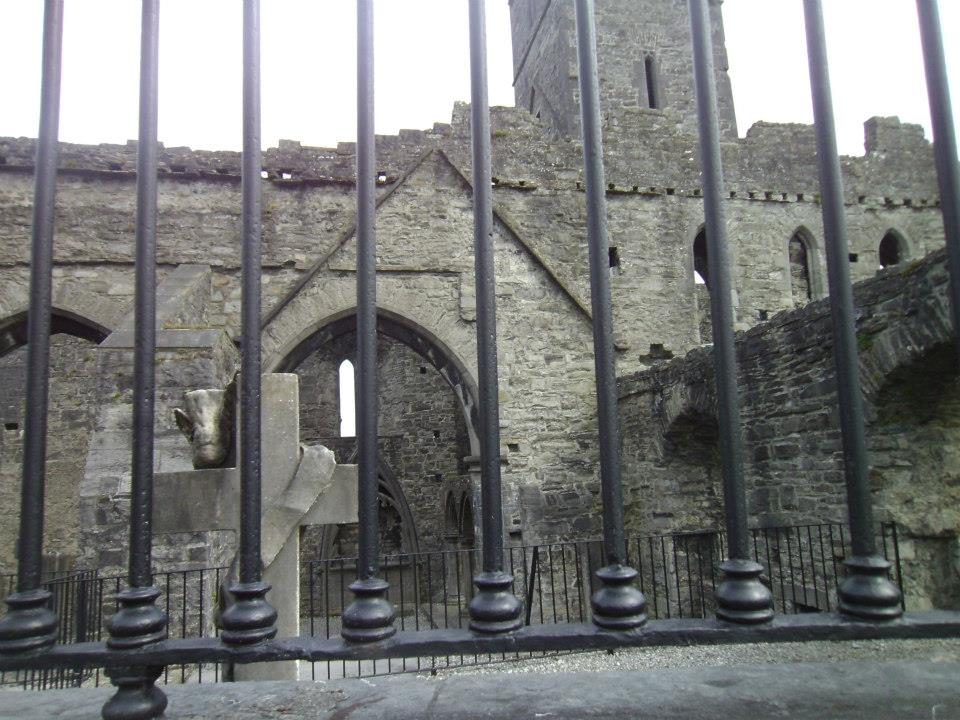
Sligo Abbey : Photo by Kelley Adinolfi
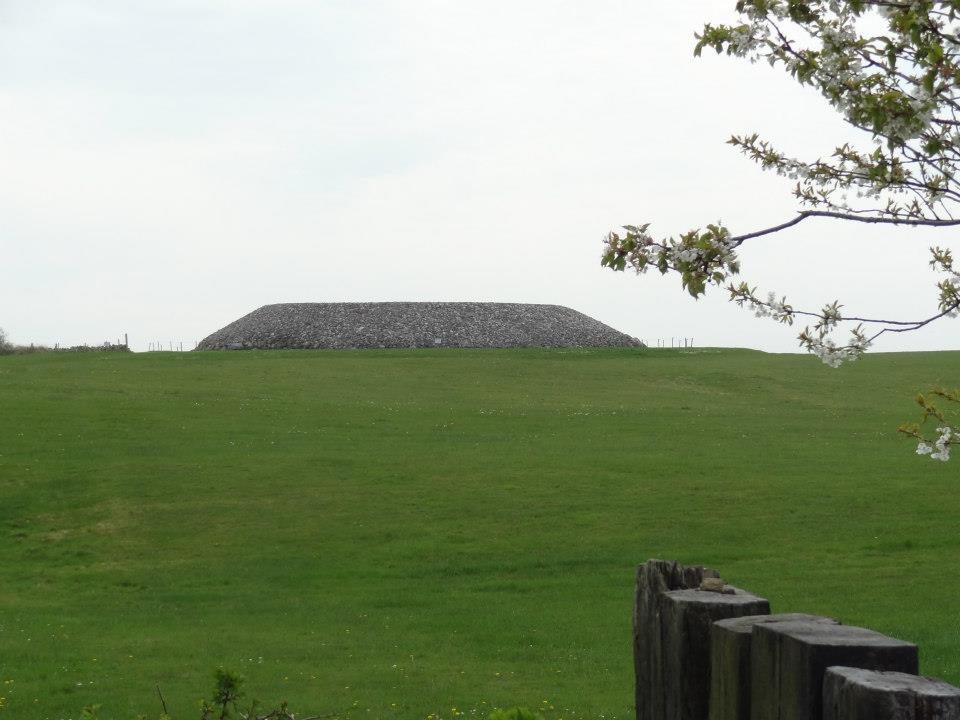
Carrowmore Megalithic Cemetery : Photo by Rose Schledwitz
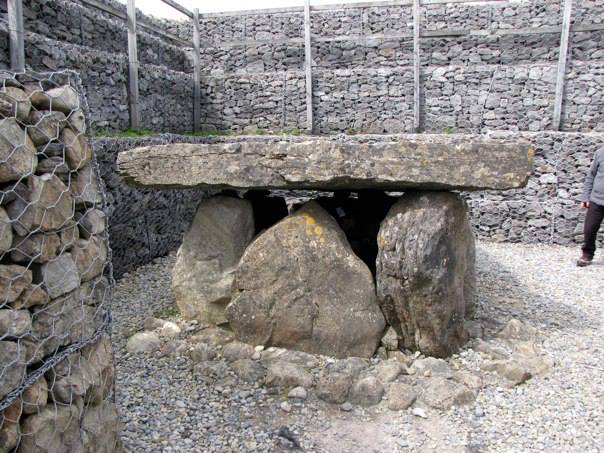
Carrowmore Megalithic Cemetery : Photo by Ed Snell
Traveling east, the tour bus stopped to visit the Marble Arch Caves. The Marble Arch Caves Global Geopark is host to one of Europe's finest "showcaves" allowing visitors to explore a fascinating, natural underworld of rivers, waterfalls, winding passages and lofty chambers. Early explorers did not like entering the cave for fear of ghosts. Lively and informative guides conduct tours past a bewildering variety of cave formations - stalactites glisten above stream ways and chambers while fragile mineral veils and cascades of creamy calcite coat walls and spread as shimmering terraces across rock strewn floors. Spectacular walkways allow easy access while powerful lighting reveals the stunning beauty and grandeur of the caves. Electrically powered boats glide through huge caverns carrying visitors along a subterranean river when the water level is safe. Our tour lasted 75 minutes and the walkways were suitable for people of average fitness. Our guide reported feeling the ghostly spirit of a fellow caver who died recently in the cave. They sense lots of ghostly pranks and uneasiness when they turn down the lights.
The final resting place for the night was historic Ballygally Castle at the seaside village of Ballygally. Voted one of the top 13 Haunted Hideaways, it is near Belfast and set on the Antrim coast along a hauntingly beautiful stretch known as the Glens of Antrim. The bus traveled along the sea coast highway and passed through the Black Cave Tunnel, also known as the Black Arch. This castle hotel dating back to 1625 was renovated in 2007 and has an abundance of Irish character and charm. According to centuries-old legend, castle owner Lord James Shaw took his newborn son and heir--then locked his wife in the tower. Hearing a baby's cry and trying to escape the tower, Lady Isobella Shaw fell to her death from a window. Another theory is that Lord Shaw himself through her to her death-or paid someone to do it. Despite her trauma, she is reputed to be a "friendly" spirit and is regularly seen wandering through the castle corridors in search for her beloved son. There are many accounts of eerie activity around the castle and several guests have felt a presence in their room or the sound of a baby crying. A green mist has been reported hovering over the castle. There is a room dedicated to the ghost in the towers of the older part of the castle.
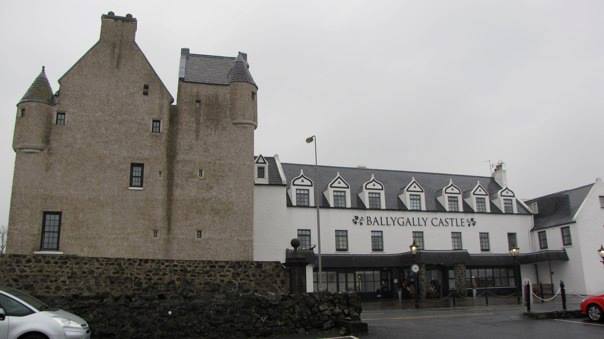
Ballygally Castle : Photo by Ed Snell
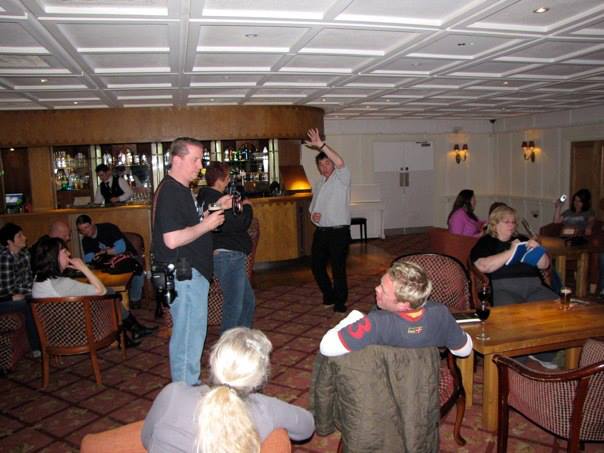
What is a Ghost : Photo by Ed Snell
Wednesday morning the Arizona ghost hunters and the rest of the Ghost Gang woke up to the pitter patter of a typical Ireland rain. After a hearty breakfast at the Ballgally Castle Hotel, the group loaded on to the bus and headed back into Belfast.
The first stop of the day was the Crumlin Road Goal and Courthouse for a tour of the facility. The Crumlin Road Gaol dates back to 1845 and closed its doors as a working prison in 1996. After extensive renovations the gaol has reopened for visitors and is comparable to Alcatraz in the United States. Today you can take a guided tour of the prison and hear about the history of the site where men, women and children were held within its walls. You will learn about the political segregation of republican and loyalist prisoners and learn why the prison was closed.
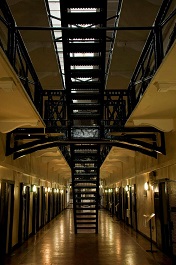 Crumlin Road Gaol Cell Blocks: |
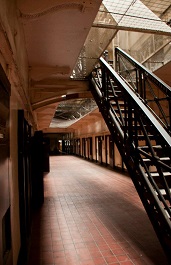 Photos by Cindy Grant |
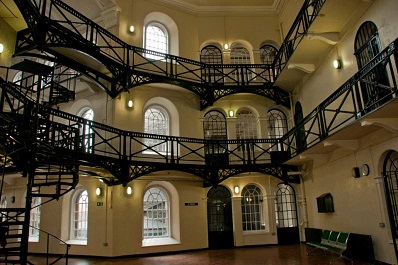 |
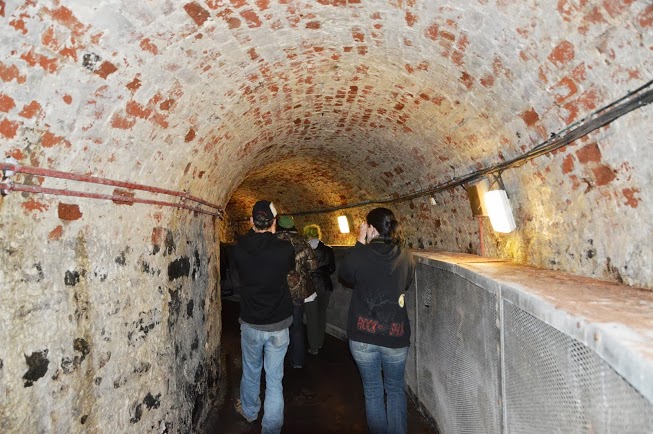 Crumlin Road Gaol Tunnel : Photo by Sherry Loggins |
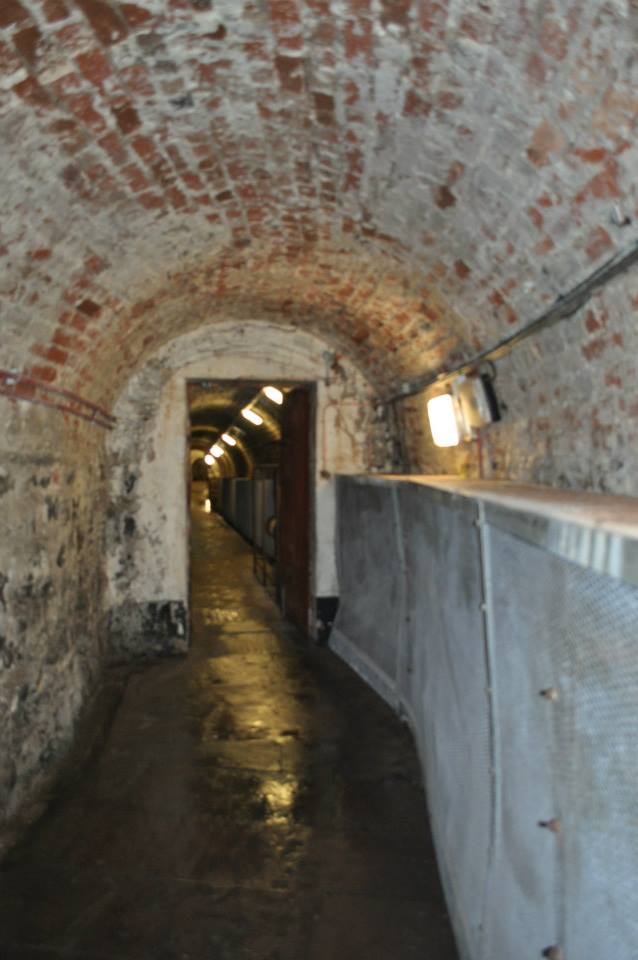 Crumlin Road Gaol Tunnel : Photo by Kelley Adinolfi |
Did we wake up the spirits?
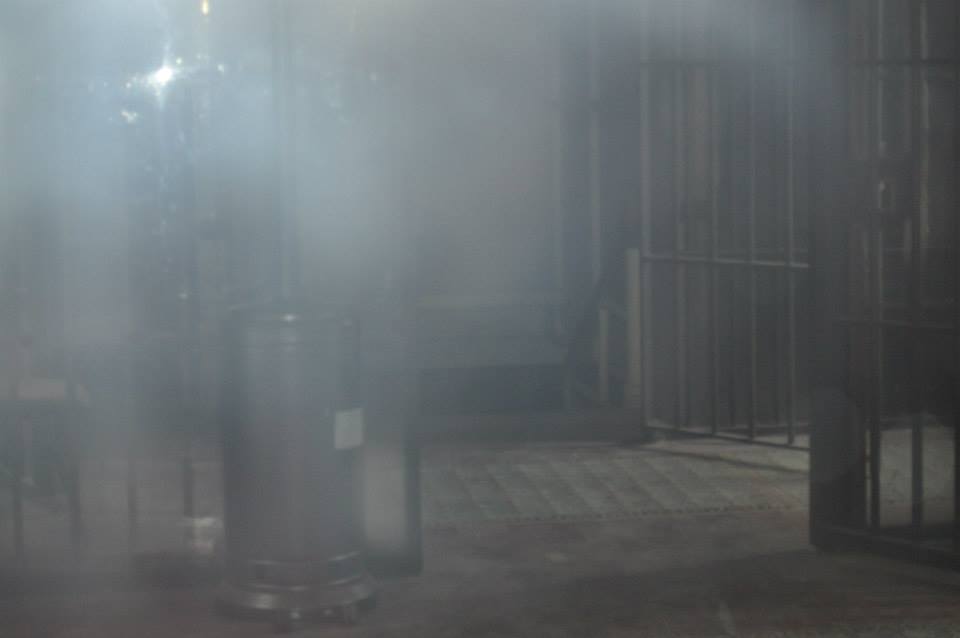 Crumlin Road Gaol Hallway : Photo by Kelley Adinolfi |
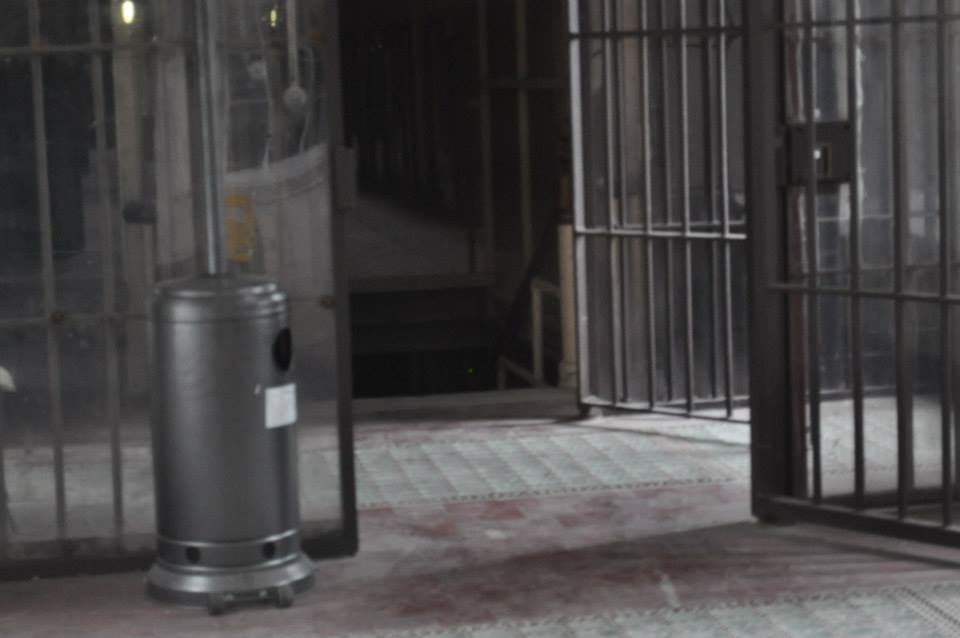 Crumlin Road Gaol Hallway one sec later : Photo by Kelley Adinolfi |
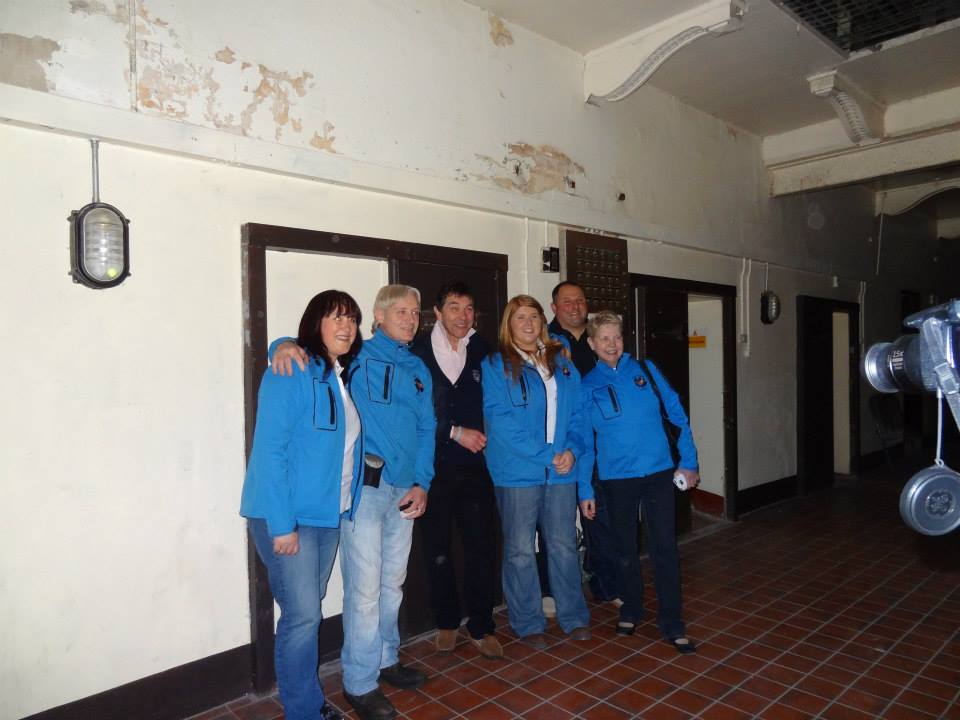 Crumlin Road Gaol GSI & Richard Felix : Photo by Rose Schledwitz |
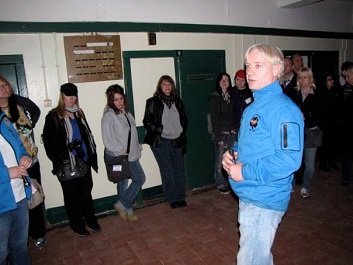 Crumlin Road Gaol : Photo by Ed Snell |
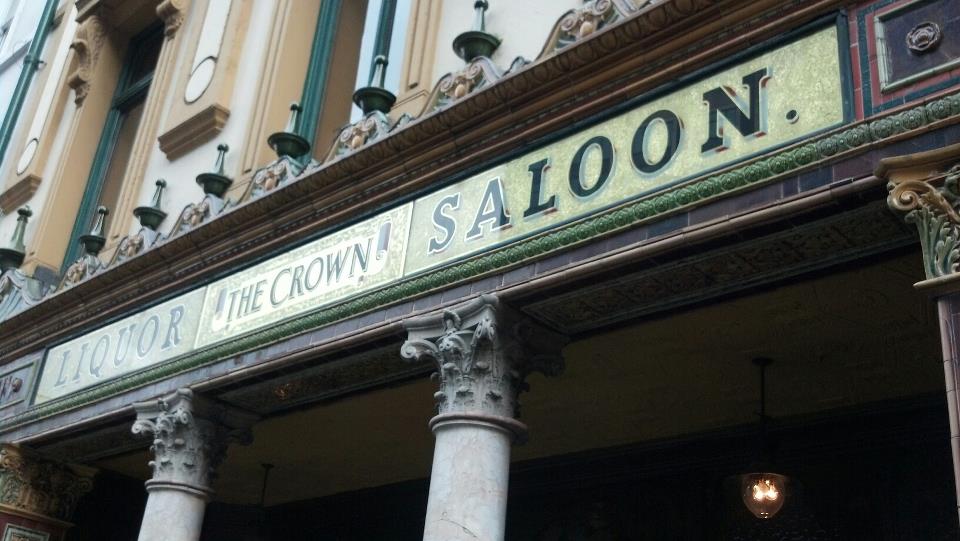
The Crown Saloon
The others chose to explore downtown the Belfast area where they had lunch (and perhaps encountered a few spirits) in one of the many local pubs. The Crown Saloon is one of Belfast's architectural gems. It was built in 1826 as The Railway Tavern and renovated in 1886. It is decorated in glazed tiles, the work of Italian craftsmen moonlighting from their daytime jobs on the Catholic churches then being built in Belfast. The interior has carved oak snugs containing gunmetal plates for striking matches and an antique bell system once used for summoning staff. The snugs were very popular in Victorian days, and in fact during the early 20th century, when people did not always want to be seen drinking in a pub. The pub has no hanging sign, apparently because of religious differences between the owners. The Protestant Mrs. Flannagan insisted on naming it The Crown but Catholic Mr. Flannagan, being against the British regime then in control in Ireland, had the workmen insert a mosaic of the crown where customers would have to step on it as they entered! It is still in place today. The waitress told stories of the ghosts in the upstairs dining rooms where silverware tends to fly across the room and voices are heard after hours. Many tales of woe haunt this old tavern like that of the prostitute Amelia who lost her life here when she fell down the stairs. Her presence is often felt within the corridors. Strange lights, voices, and other strange activity have been recorded here. The ghost gang met up again at 4:00 pm and headed south to Cabra Castle located outside of the town of Kingscourt. Cabra Castle is one of those storybook looking castles that every young girl dreams of. Cabra Castle boasts a proud history dating as far back as 1760. The castle history offers a mature, cultured air to the castle which can be felt as one strolls along the castle's impressive hallways and stairwells. The Ghost Gang was escorted to the cottages-or the old renovated stables and servants quarters. The buildings have now been converted to elegant rooms in a rugged, rustic setting.
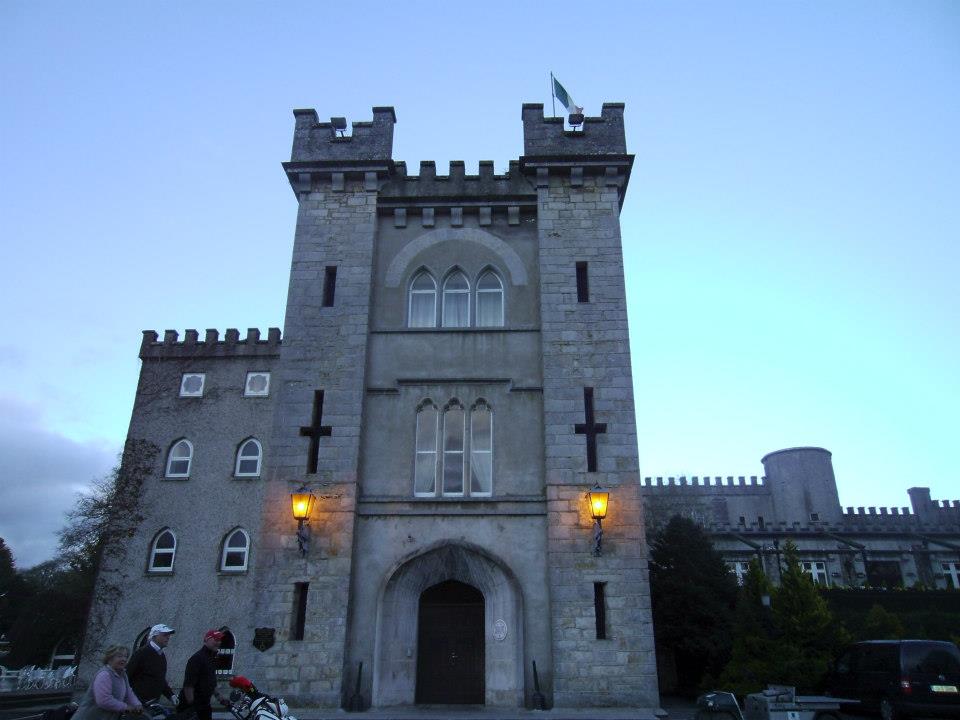
Cabra Castle at night
Dinner was served at round tables in the dining room in the main castle. Everyone could not resist petting "Oscar," the castle's old Irish wolfhound. After dinner some of the group lingered and socialized in the bar area while others did a little ghost hunting in the many hidden passageways throughout the castle.
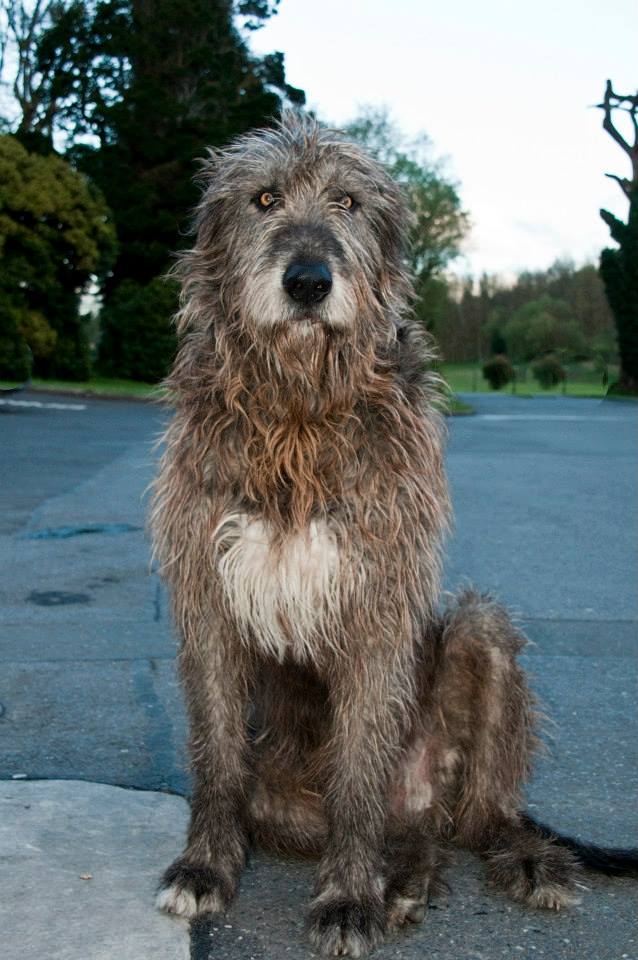
Oscar the Irish Wolfhound : Photo by Cindy Grant
Who would have ghostly visits in their rooms in the middle of the night? Will Oscar move from the comfort of his doggy bed?
Day 4: Rock of Cashel, Blarney Castle, Kinnitty Castle
Everyone on the Ireland Tour had an amazing night at Cabra Castle and their unique accommodations. Some of the tour guests reported hearing footsteps in their rooms, voices, and items move from place to place before their eyes. Let day four begin!
Cabra Castle dates from 1760 and is known to be one of Ireland's scariest castle hotels. Some guests have spoken of meeting a man in full early 20th century military uniform striding down the corridor. Another guest heard a horse and carriage pull in to the courtyard in the dead of night just before depositing a screaming infant at the steps of the hotel. There is also an old hanging tree on the grounds. The Cabra Castle Hotel tells their version of the story:
"'In the 1780's, the local people of Dun na Rí witnessed the unfolding of the tragic saga which was to become the legend of the ghost which still haunts Cabra Castle to this present day - dare to walk the corridors of this haunted castle knowing that the footsteps that went before you were that of evil predecessors. The then owners of the castle had a daughter and two sons, one of whom fell in love with a servant girl called Sarah. In true Romeo & Juliet style, it was a passionate but secret love, which for the sake of property, could only be pledged silently.
The secret was broken when Sarah became pregnant and her lovers family ordered that she was to be killed; legend has it that she was taken from the Servants Quarters of the castle and dragged deep into the forest, where her body was hung over a bridge.
It is said that in the dead of the night, the haunting cries of a baby may still be heard in Cabra Castle. Local people say that the baby is pining for its mother. There is also a testament by those who have felt a 'presence' in the courtyard rooms - formerly the Servant's Quarters, where it is said that Sarah's lost soul still wanders the Castle in search of her lost love and lost child..
The forest where she alleged met her death, is now open as a park and the bridge which Sarah was hung has been named 'Sarah's bridge'. In honor of the legend and in her memory, there is a room in the Castle that we have named after her - 'Sarah's Well'.''
Soon the bus was loaded and the tour began a journey to Rock of Cashel (AKA St. Patrick's rock) in Tipperary. This Irish castle sits atop a gigantic limestone (perfect for a haunting) outcropping that rises to a height of 358 feet. The stone fortress wall encloses the ruins of great medieval structures including the Irish-Romanesque Cormac's Chapel.
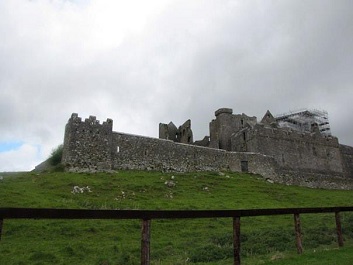
Rock of Cashel : Photo by Ed Snell
Legends about the castle range from the whimsical to the historic. The legend claims that the rock was hurled by the Devil when he spied a church being built at Cashel. But, the evil one had a bad aim, and the Christians were unafraid. More likely, St. Patrick-the Briton who legendarily endured danger and hardship to convert Ireland to Christianity-did baptize King Aenghus of Munster at Cashel about AD 450, thus establishing Cashel as a bishopric. It is not surprisingly that St. Patrick's Rock is haunted. The wind adds a strange atmosphere. The cold grey sky, the cold grey stone, and the old graves, made an eerie place of 'The Rock.'"
It was very windy as the ghost gang trudge up the steep hill to visit Cashel. There is a wonderful old cemetery on the grounds with a lot of photo opportunities. It is no wonder that ghostly monks have been showing up in guest's photographs over the years.
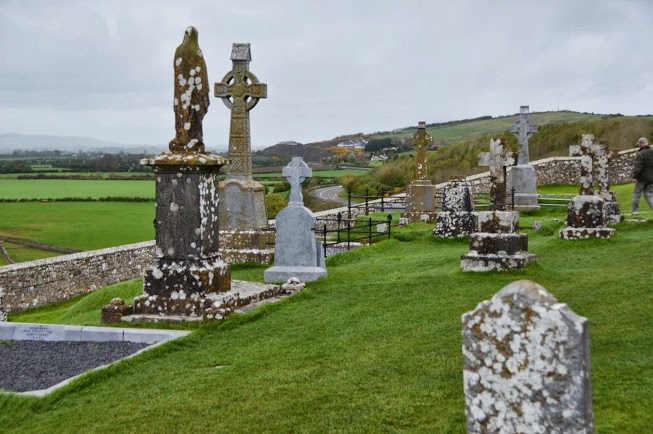
Rock of Cashel Cemetery: Photo by Sherry Loggins
After lunch we were whisked away to Blarney Castle. Kissing the fabled "Blarney Stone" was on many bucket lists and is listed on the 100 places you must visit before you die. The legendary Blarney Stone is said to have the power to bestow people with the gift of gab and the ability to speak with wit, charm and persuasion.
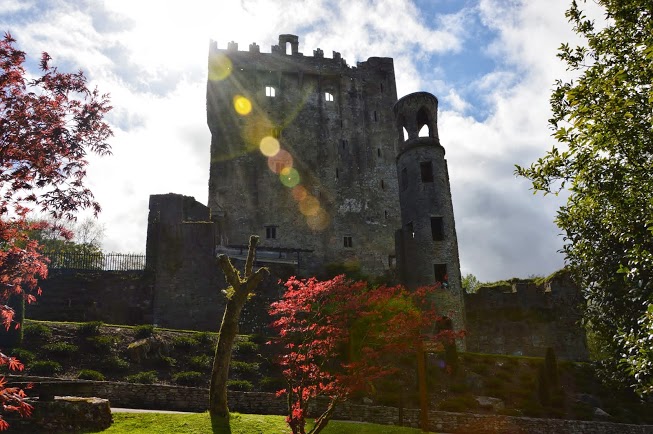
Blarney Castle : Photo by Sherry Loggins
The stone is built into the wall of the medieval Blarney Castle in County Cork. Sir Winston Churchill is the most famous world leader to kiss the stone and celebs such as Laurel and Hardy, and Mick Jagger also have a lot to thank it for. Thousands of tourists have come to Blarney Castle each year to kiss the stone---and now the Ghost Gang has done it too!
There are many legends that tell how the stone became a source of power. One is that Cormac Laidir McCarthy, the man who built Blarney Castle, had been taken to court. He was very worried that he was going to lose his case so he prayed to the goddess, Cliodhna-who was Queen of the Banshees. Cliodhna advised him to kiss the first stone he saw on the way to court. McCarthy followed her advice. He pleaded his case in such an articulate and persuasive manner that he won his case! Word was spread about his success by kissing the stone and the legend was born!
Blarney Castle history is an intriguing one. It was the third structure to be built on this site. The first one was a wooden structure built in the 10th century, and a stone structure replaced it in 1210 A.D. This building was torn down because of foundation problems, and the final, medieval Blarney Castle was built by Dermot McCarthy in 1446. At one time, the castle was occupied by Cormac McCarthy, King of Munster, who allegedly sent 4,000 Munster men to held Robert the Bruce at the battle of Bannockburn. According to legend, Robert the Bruce gave half of the Stone of Scone to McCarthy in gratitude, which was incorporated into the structure of the castle, becoming the Blarney Stone.
With the newly required gift of blarney (as if any of us needed more) it was back on to the bus for a ride up to Kinnitty Castle-one of the most haunted castles in Ireland, and where the ghost gang would be spending the night!
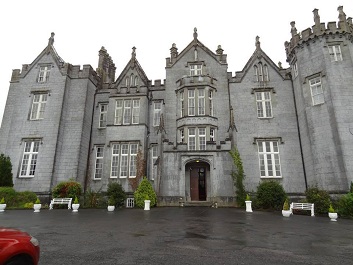
Kinnity Castle : Photo by Rose Schledwitz
Kinnitty Castle was another gothic revival Castle and is located at the foothills of the Slieve Bloom Mountains in County Offaly. Some of the tour guests were given rooms within the Castle walls while others were assigned rooms that surrounded the courtyard. Dinner was served in a medieval banquet room with long tables and period music.
Who would become a human pendulum? Would there be table tipping? Who would have paranormal happenings in their rooms during the night? Will the fairies in the forest surround the castle walls?
Leap Castle, Bunratty Castle & Folk Park, Durty Nelly's, Dublin Ghost Tour
After breakfast, Richard Felix took the group on a quick tour of the castle grounds and told them about some of the ghosts of Kinnitty Castle. The Gothic Revival Kinnitty Castle is located in the heart of Ireland in County Offaly, and has a long history. The first stronghold was destroyed in 1209 and rebuilt by the Normans around 1213 on a spot once inhabited by druids and bards. The castle changed owners many times. Lady Catherine Hutchinson became the owner of the castle in 1811. It was burned down by the Republican forces in 1922. The castle was restored and transformed into a wonderful hotel with dark hallways and sweeping staircases. The grounds feature the remains of an Augustinian Abbey and an ancient Celtic High Cross. The cross is carved with biblical scenes and located in the gardens.
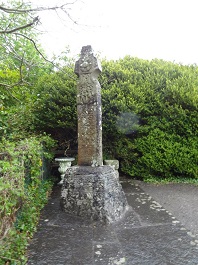
Celtic Cross :Photo by Rose Schledwitz
The castle has its own resident ghosts. A ghost of one of the departed monks from the abbey is said to find the ambiance of the castle quite inviting and is seen wandering the darker corners of the Banquet Hall. He stands very tall and is always dressed in black. He is able to predict and foresee the future and passes messages though staff members. Allegedly, everything that he predicts comes true. He has also been known to haunt the dungeon bar of the hotel.
Richard and Edd Felix tried to make contact with the spirit in the balcony of the banquet room with a séance that included table tipping, communications with a wine glass, and using Debe Branning as a human pendulum.
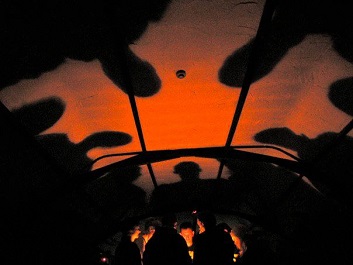
Photo by Ed Snell
There is also a ghost in the Geraldine Bedroom where many people have sensed a presence of a spirit of a whimpering child. There is also a circle of Celtic stones near the Con Ryan cottage in the back of the castle. The cottage looks like something out of an old fashion storybook.
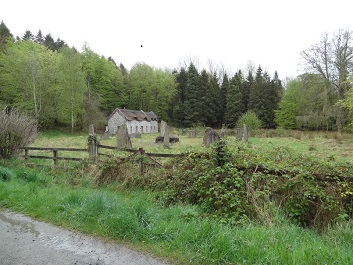
Standing Stones :Photo by Rose Schledwitz
The Ghost Gang on the Haunted Tour of Ireland headed back on the bus after a good night's sleep in haunted Kinnitty Castle. Leap Castle and Bunratty Castle and Folk Park was on the agenda for the day's adventures.
Just a little further along the road, another castle was awaiting the tour's arrival-the notorious and most haunted, Leap Castle. This castle is also located in County Offaly-about four miles north of the town of Roscrea. It is believed the structure was built around 1250 AD. It too, has had many owners including a bitter fight for power of the O'Carroll brothers. One of the brothers was a priest. The O'Carroll priest was holding mass for members of the family in what now is called the "Bloody Chapel" when his rival brother burst into the chapel and plunged a sword into his brother and killed him.
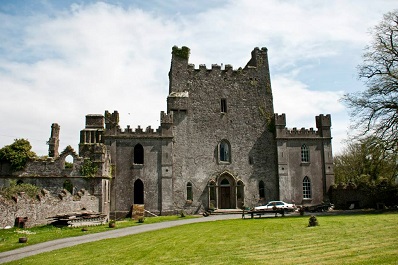
Leap Castle :Photo by Cindy Grant
The Ireland ghost gang was honored to have renowned flutist, Sean Ryan-the owner of Leap Castle since 1991 as our host and guide at the castle. Ryan, who is continuously restoring parts of the castle, graciously invited the tour into his home and told ghost stories that he and many friends had witnessed. TV programs such as "Most Haunted" and "Ghost Hunters" have filmed at Leap Castle and investigated these haunted tales.
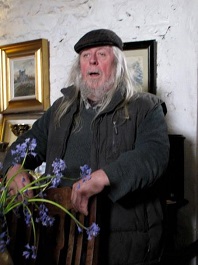
Sean Ryan :Photo by Ed Snell
Sean Ryan spoke to the group and declared he does not fear the ghosts at Leap Castle. They hear a lot of strange sounds in the castle late at night (and occasionally a few screams) but for the most part, the most active ghosts are two young girls they call Catherine and Emily. Every time Sean mentioned the playful young girls, the front door would open slightly on its own. There is also a ghostly women often seen called the Governess. Many visitors have witnessed an older man just sitting in a chair near the entry engaged in the happenings of another realm. Often he is seen sitting in the same spot for several hours.
Sean Ryan was knowledgeable of Irish history and its legends. Before we left he told us the story of a blind musician of the O'Cahan (O'Kahane) Clan and how he created the haunting melody of today's "Danny Boy." Sean proceeded to entertain us with the song. It was quite fitting considering one of the members on the tour was a descendant of the O'Cahan (O'Kahane) Clan. (Kane). He too is a budding musician.
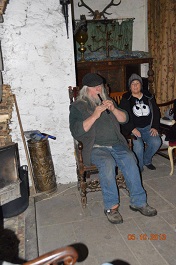
Sean Ryan :Photo by Rose Schledwitz
The group was a little late traveling to its next destination-but that was one time they did not fret. It was on to Bunratty Castle & Folk Park in County Clare. Before entering the castle grounds, many of the tour members had lunch in Durty Nelly's. Durty Nelly's was established in the 1620's. Nelly always found a way to make ends meet and was the keeper of the toll bridge over the river Owengraney which flowed outside her window on its way to join the Shannon. She was known for her generously hospitality to weary travelers. It was one of these rogues who stole her savings-all the gold coins she had collected at the bridge. She created a magic brew of whisky from her distillery in the woods that healed feeble dogs, made childless couples virile and strong, and relieved aches and pains. Travelers came from miles to have a drink and soothe their woes.
Across the road was Bunratty Castle. The Castle is the most complete and authentic medieval fortress in Ireland. Built in 1425 it was restored in 1954 to its former medieval splendor and now contains mainly 15th and 16th century furnishings, tapestries, and works of art which capture the mood of those times. Today, the castle stands peacefully in delightful grounds. The houses and cottages of the folk park spread out at the foot of its massive walls, much in the way that the cottages and crofts of old would have clustered around its base. You can wander through the castle and marvel at the finest collection of medieval furniture in the country which brings to life a vital part of the Medieval past.
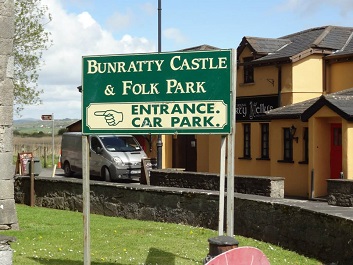 Bunratty Folk Park :Photo by Rose Schledwitz | 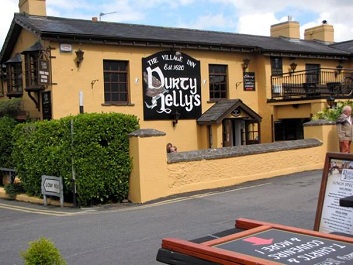 Durty Nellies:Photo by Ed Snell |
Soon everyone was back on the bus and ready for a long drive back into Dublin. On the way back the Irish skies were lined with rainbows, double rainbows, with the pots of gold looking to be just an arm's reach from their seat on the bus.
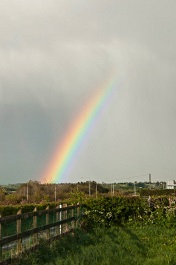 Rainbow :Photo by Cindy Grant |  Rainbow :Photo by Rose Schledwitz |
Our guide with Hidden Dublin Walks took the group to several historic locations and told grizzly ghost tales about the buildings. The highlight of the tour was the last stop which happened to be the eerie grounds of St. Audoens Church. It is said the ghost of Darky Kelly wanders the gates to the catacombs known as "Hell" due to its whorehouses and drug dens. Upon entering the grassy park area to the side of the church after the guide locked the gates behind the tour, and you could almost feel an eerie presence keeping its watch. Be sure and take lots of photos as you descent the 40 steps down to the gate of "Hell" as Darky Kelly is said to haunt the steps.
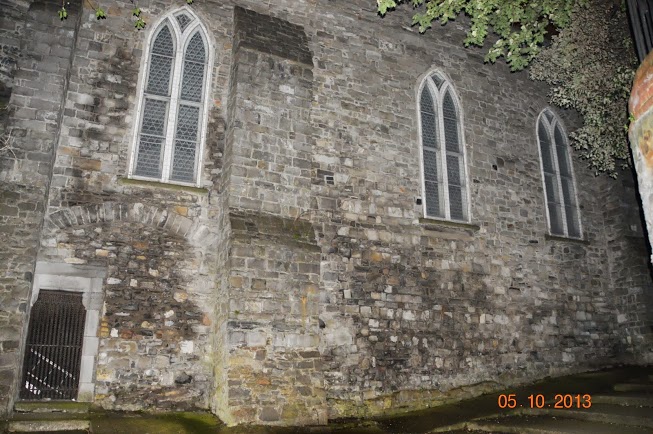
ST AUDOEN'S CHURCH :Photo by Sherry Loggins
Day 6: St. Michan's Church, Guinness Storehouse, Jameson Distillery, Kilmainham Gaoll, Dublin Zoo, Philip Lynott Statue, Museums, Tattoos, Shopping and the gala Masquerade Ball
Saturday morning began at the St. Michan's Church in the heart of Dublin. Many of the tour members met at St. Michan's Crypts where they came face to face with the mummified dead in the underground vaults. St. Michan's is the oldest parish church on the north side of Dublin and was founded in 1095. Underneath the church are five long burial vaults accessed through iron doors in the graveyard. Visitors since the Victorian times have descended the vault steps to see the mummies-and Bram Stoker is believed to have visited the vaults in the company of his family. The ghost crew took photos of the thief, the nun, and touched the fingertip of the alleged crusader.
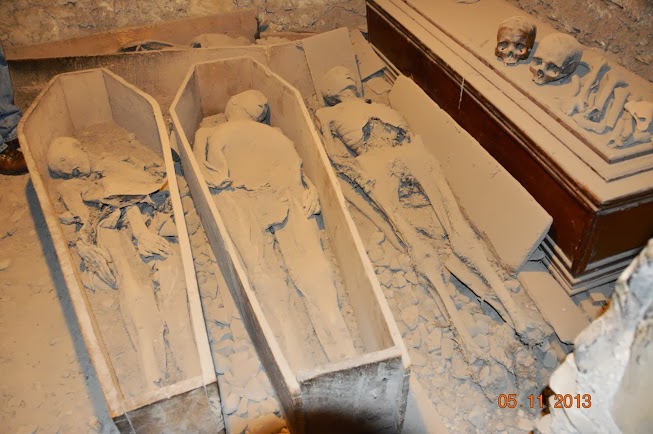 Mummies :Photo by Sherry Loggins | 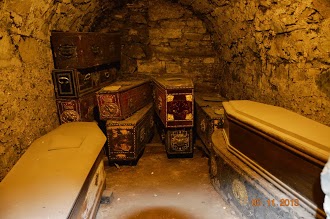 Mummies :Photo by Sherry Loggins |
Prior to the trip, a few of the Ireland travelers had discussed posing with the statue of Philip Lynott of Thin Lizzy-sort of Dublin's version of the statue of the man "standing on the corner in Winslow, Arizona." In fact, the two pieces of artwork happen to be modeled in a similar stance. The plan was to meet up in downtown Dublin-have a pint-and strike a pose with Lynott to sort of cap off the tour. Little did they know, just two nights before they arrived, a couple of men leaving a nearby pub tackled the statue-sending it off for repairs. Never the less, they met at the location as planned and stood on the spot where the Phillip Lynott statue 'would have been' had he not taken a tumble..
Later that evening the ghost gang was back in their rooms at the Ballsbridge Hotel preparing for the big masquerade party. As each guest wandered into the banquet area, the group cheered and snapped photographs of their friends dazzled in many creative costume ideas! Some of the other hotel guests even popped in and snapped a few photos. Everyone attending the costume ball was a winner! There was good food, lots of dancing, and even a ghostly poem written and recited by one of the tour members (see below). An odd-looking leprechaun showed up to lead the festivities.
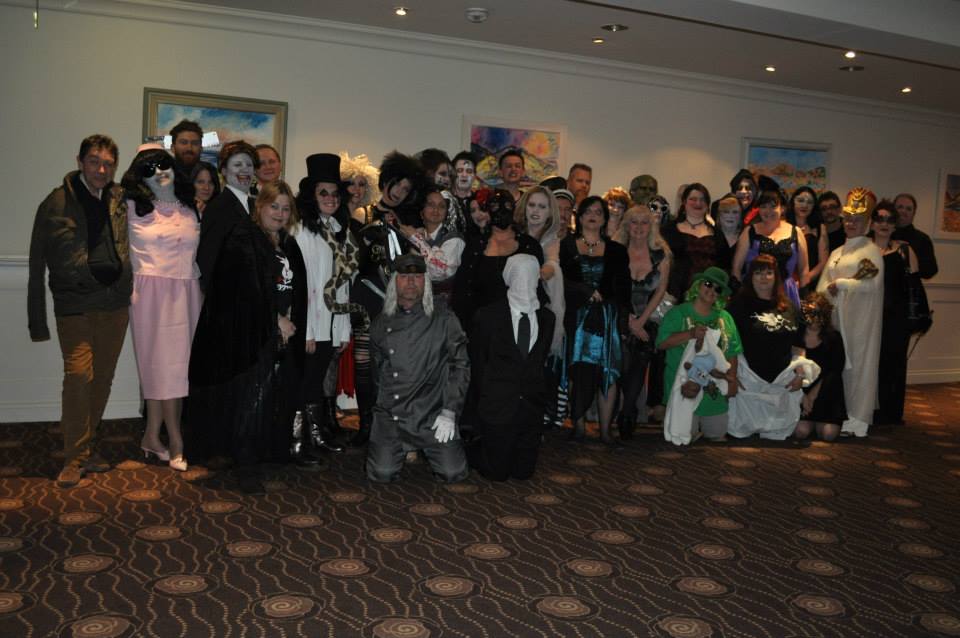 Group getting ready to Party | 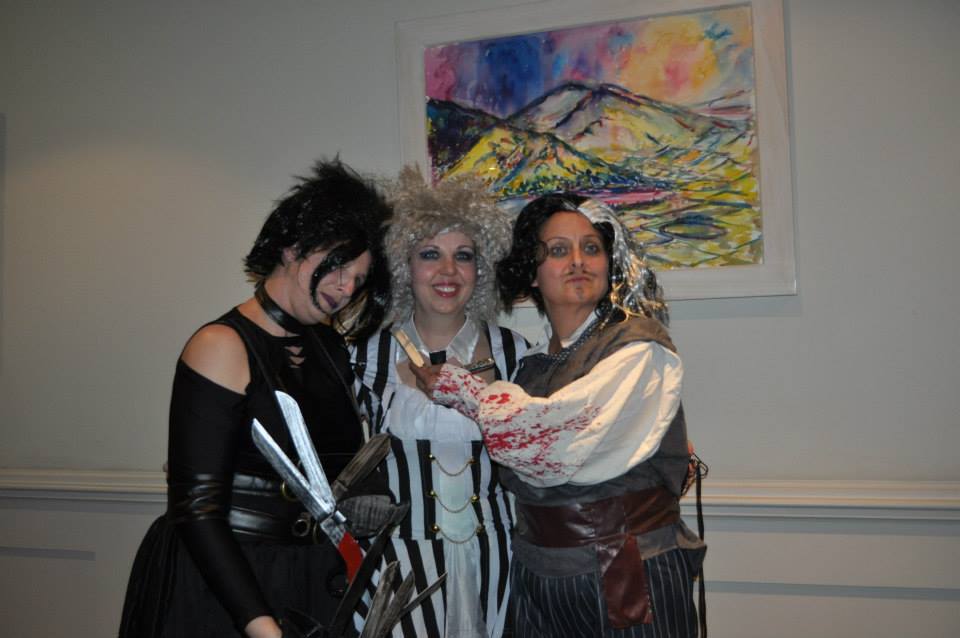 Photo by Sherry Loggins |
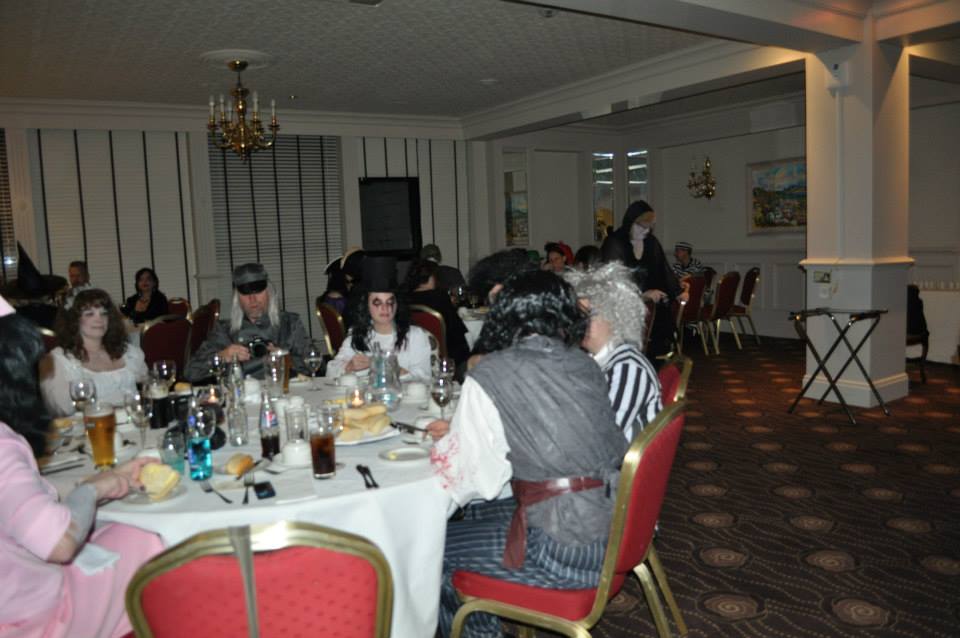 |
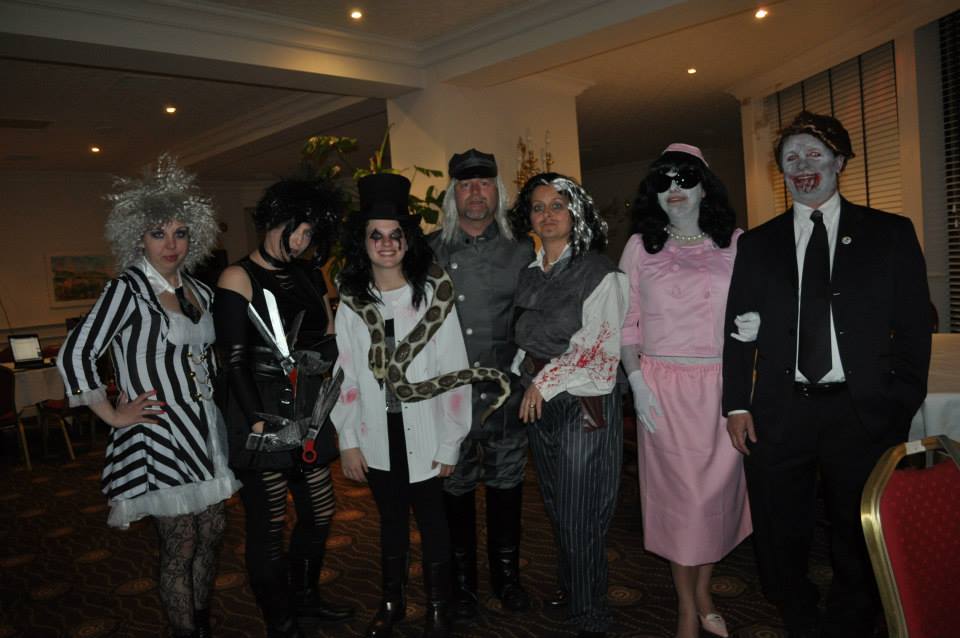 |
Sunday morning there were tears, laughter, and many hugs and photos as the group bid farewell to their ghost hunting buddies and they boarded the bus one more time. Now they would be on the way to the airport to catch various flights to their home destinations. It is always an emotional time to thank our ghost host, Richard Felix, and bid him farewell in hopes we see him again on yet another most haunted adventure. All of us have come to love and respect this gentleman as another member of our macabre family. He is always knowledgeable about the ghosts & history of the places we visit.
| A THING ABOUT GHOSTS* Poem by Jeffrey A. Barach, written March 4, 2013 |
|
A thing about ghosts that I need to explain Is once you have seen them, their plight will remain And over and over you'll see them again Until they forever are etched in your brain And you become like them and suffer their pain. For me, where it happened, is not hard to find. But I'll not go back there, not even near to it. You may think that I'm weak or losing my mind. But I'd like to explain just why I can't do it. It's been a long while maybe ten years or so, To Ireland I came, my ancestral home, To stay for a month, in my county Mayo, In castle hotel, with towers of stone, And vine-covered walls put up eons ago. Because I came late, they did open for me, A seldom-used room up a stone spiral stair, Atop a stone tower embraced by the sea. The walls were cold stone, the furniture spare. The window blew open, in spite of its frame, And filled the small room with the cold salt sea air The surf and the thunder were nearly the same. And lights seem to flicker like meek candle flame. My second night there, so to brace me for bed, I drank lots of Bushmills to mellow my head. As I went to bed, gripping bannister there. I saw a vague figure: young maid on the stair, All dressed in white lace with a long satin train. She went up the tower in spite of the rain. Then gone in a whisp, before I could think. By now I was sure I'd had too much to drink. My room was all wet from the window blown free I rushed up to close it, and then did I see, What looked like that maiden fall through the air Into the grey spume of the hard breaking sea. I sat on the bed, with my head in a swirl, Had I really seen that ghostly white girl? My mind wasn't clear and the whisky was strong. Maybe I had fancied it all, all along. Next morning I asked every person I found And wandered the castle, all over the ground, But no one had seen her, or heard of a ghost. I figured 'twas some sort of dream at the most. For several days, I did see her no more, Untill late one night, after drinking galore. And then it all happened, again as before. I saw her white shade as it flew up the stair And from my small window in moon's ghostly glare, I saw the same sprite as it fell through the air. I now was quite nervous and very upset. I wrote the details so as not to forget. 'Twas clear that I'd seen her when it was quite late, And frankly I'd not been in sober estate. I had to conclude that the ghost was all bunk, From castle mystique and the whisky I'd drunk. Next day as I wandered in drizzle and gloom, I past rows of roses, most all in full bloom I picked one and took it right back to my room. While climbing the stair to my room in the tower, I saw a small holder for candle or flower. It was further up, where I'd seen the white vision With heart beating hard, without rhyme or good reason, I climbed up the stair and I put the rose in it. Then drank a large scotch the very next minute. I woke late that morn, with an ache in my head, And saw....the same rose....on the stand by my bed. I gasped for my breath, like an asthma attack. Not bathing or shaving I hurried to pack. I fled that small room, and the castle hotel. But more's to the story, I'm sorry to tell. The rose, it's the rose, what on earth did I do? It came from beyond, that I finally knew. Inspite of my fear, I took it, in case, I tried, ever tried to forget what took place. It took a long while, but I did some research, In hope of some inkling of truth to extract. Then finally, deep in a book in a church, I found an account of some lovers, in fact. Whose story had happened all during the war. When news of his death came to castle's front door, A maiden all dressed in her bridal trouseau Had thrown herself into the storm-driven sea. Believe, when I tell you, her husband to be, Was part of a family, related to me. So you can go there on your Irish ghost tour, But I'll not be there, I am not that secure. There's too much to risk and too little to gain, Encountering ghosts, as I've tried to explain. If once you do see them, their plight will remain And over and over you'll see them again Until they forever are etched in your brain And you become like them and suffer their pain. *Copyright © Jeffrey A. Barach, Westwego, La 70094 |
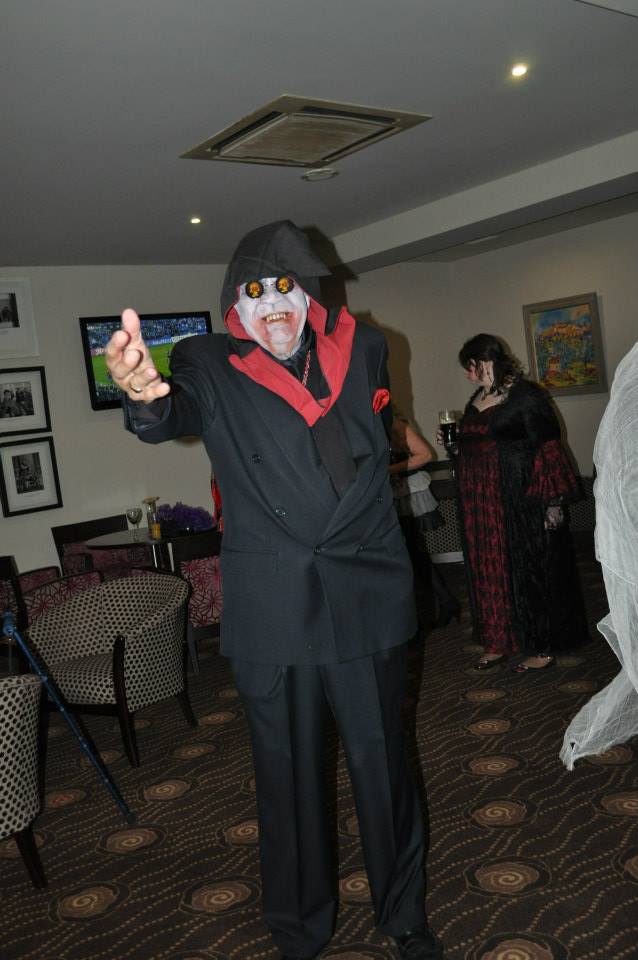 |
Tour report by Adam Drendel

Click Here For Free Color Brochure
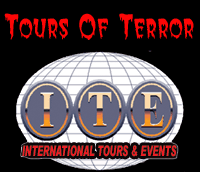
315 Derby Avenue, Orange, CT 06477 USA
Tel: (203) 795-4737 Fax: (203) 891-8433

TOURSofTERROR@aol.com

